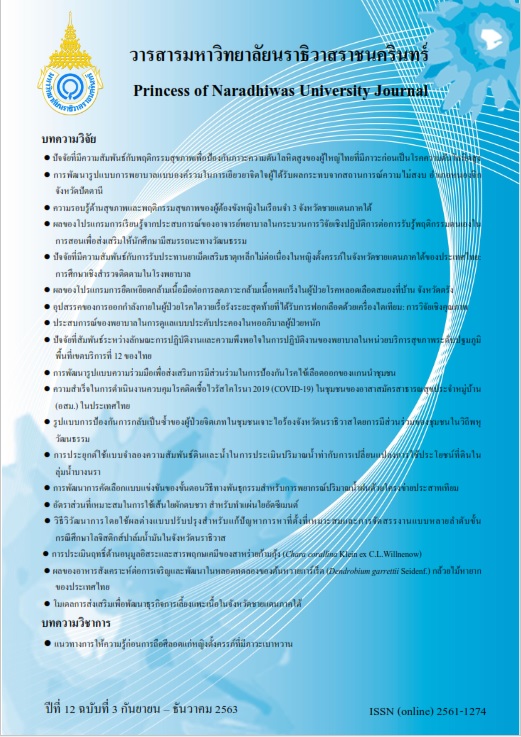Development of Collaboration Model for Promoting Participation in Dengue Hemorrhagic Fever (DHF) Prevention of Community Leaders
Keywords:
Participation, Dengue hemorrhagic fever, Community leadersAbstract
This developmental research aimed to investigate factors influencing community leaders to participate in DHF prevention, to develop collaboration model and to determine effectiveness of collaboration model for promoting participation in DHF prevention of community leaders of Singhanokhon district, Songkhla province. The research was implemented with 3 phases. Phase 1 was to study factors influencing participation in DHF prevention. A total of 85 community leaders of Singhanokhon district, Songkhla province were selected by stratified random sampling. Data were collected with a questionnaire, which had Cronbach alpha coefficient of .856, and were analysed using multiple regression. Phase 2 was to develop and draft a model based on literature review and the first phase results, then validated by a panel of experts. The data were analysed using percentage. Phase 3 was to study the model’s effectiveness. A total of 68 community leaders were recruited from sub-districts with purposive sampling. The tools used were collaboration model and a participation questionnaire. Data were analysed using descriptive statistics and paired t-test. Results revealed as follows:
- 1. The collaboration factors influencing community leaders to participate in DHF prevention had shown statistically significant at .001 (p = .001) with 51.0% (adj.R2 = .510, p < .001).
- 2. The collaboration model for promoting participation in DHF prevention of community leaders of Singhanokhon district, Songkhla province included 1) mutual encounter and acceptance of problems, 2) mutual sharing vision, setting goals, planning and implementing, 3) managing an effective coordination system and 4) achieving mutual outcomes.
- 3. After applying the collaboration model, it was found that the community leaders of Singhanokhon district, Songkhla province had significantly higher mean score of participation in DHF prevention than that of before (=3.80, SD= 0.65) vs (=2.79, SD= 0.71) (p=.001).
Therefore, this collaboration model should be used for planning on solving problems and establishing sustainable prevention and control of DHF through collaboration of all sectors.
References
Agranoff, R., & McGuire, M. (2003). Collaborative Public Management: New Strategies for Local Governments. Georgetown University Press.
Areesoponpichet, S. (2007). The development of collaborative strategies for social sciences research in Thai public higher education institutions. A dissertation degree of doctor of philosophy program of higher education. Faculty of educational. Chulalongkorn University. (in Thai)
Cohen & Uphoff. (1980). Effective Behavior in Organizations. New York : Richard D. Irwin Inc.
Department of Disease Control, Ministry of Public Health. (2019). Dengue Fever Prognosis Report 2019. Retrieved April 1, 2020 from https://ddc.moph.go.th/uploads/ckeditor/ 6f4922f455 68161a8cdf4ad2299f6d23/files/Dangue/Prophecy/2562.pdf.
Gibson, H C. (1995). The Process of Empowerment in Mothers of Chronically III Children, Advance Nursing. 21: 1201-1210.
Hair, F.J., Black, C.W., Babin, J.B., & Anderson, E.R.(2010). Multivariate Data Analysis (7th ed.)New Jersey: Pearson Education.
House, J. S. (1981). Work stress and social support. Michigan: University of Michigan.
Laohapichatchai, W. (2013). The effectiveness of the health education program by applying group processes affecting dengue fever prevention and control behavior Of health volunteers Phra Nakhon Si Ayutthaya province. Bangkok: Srinakharinwirot university. (in Thai).
Polpong, M., Nima, S., & Petchuay, P., (2017). Development of a Participative Model for Prevention and Control of Dengue Hemorrhagic Fever in Koksak Sub District, Bangkeaw District, Phatthalung. The Southern College Network Journal of Nursing and Public Health. 4(special): 243-259.
Poung-ngam, K. (2015). Local innovation of the local government organization (2rd ed.) Bangkok: Sema Dharm. (in Thai).
Songkhla Provincial Health Office. (2018). Summary of report of dengue fever epidemic (Report 506). Epidemiological surveillance program. (in Thai)
Suapumee, N., Chittayanunt, K., Wongrattanarak, W., & Naksrisang, W. (2015). Effectiveness of the Dengue Hemorrhagic Fever Prevention and Control Program in Community using a Participatory Learning Process. Nursing Journal of the Ministry of Public Health, 25(1), 25-39.
Suwanbamrung, C. (2014). The Results of Problem Situation and Larval Indices Management Assessment Based on Mixed Method and Community Participation Approach for Preparing the Dengue Problem Solution in KumpheangSou Sub-district, Nakhon Si Thammarat Province. Area Based Development Research Journal, 6(5), 54-75.
Suwanbamrung, C., Thougjan, S., Ponprasert, Situka, P., Tapkun, B., Mopraman, & P. Chaiya. (2018). Model” the Network of Aedes Aegypti Larval Indices Surveillance System for Sustainable Dengue Solution: The Results from Transmitting Technology to Community. Area Based Development Research Journal, 10(1), 70-87.
Suwanbamrung, C., Thuethong, C., Eksirinimit, T., & Thongchan, S. (2018). The Development of Larval Indices Surveillance System for Dengue Prevention in High Risk District, Nakhon Si Thammarat Province. Journal of Community Development and Life Quality. 5(1), 58-76.
Tappa, J. & Ditchareon, D. (2013). The develop the model of people, s participation in prevention and control of dengue hemorrhagic fever: a case study of the Thapho community, Chom Tong locality, Capital distric, Phitsanulok province. Phitsanulok: Office of Disease Prevention and Control 2, Phitsanulok Province. (in Thai)
Tippratum, C., Kongklay, J. & Kittisakwin, C. (2017). The Role of Rewards in Human Resource Management. Journal of Graduate Studies Valaya Alongkron Rajabhat University 11(1): 190 – 201.
Wayne, S. J. (2002). The role of fair treatment and rewards in perceptions of organization support and leader-member exchange. Journal of Applied Psychology. 87(3): 590-598.
Weiangkham, D., Ponmark, J., Kandee. P., Kosolwat, S., Kantamoon, N., & Prommongkol, S. (2017). The Effect of Dengue Hemorrhagic Fever Prevention Program on Knowledge, Attitude and Practice of Community Leaders in Muang District, Phayao Province. Journal of Nursing and Health Care, 35(1), 207-214.
Yokjinda, W. (2014). Public Participation in Communication Development of Thungklang Villege Thambol Thap Sai Amphoe Pong Nam Ron, Jantaburee Province. Burapa University. (in Thai).




